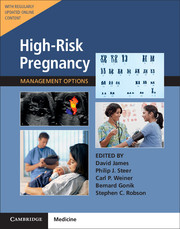Book contents
- Frontmatter
- Contents
- List of Contributors
- Preface
- Section 1 Prepregnancy Problems
- Section 2 Early Prenatal Problems
- Section 3 Late Prenatal – Fetal Problems
- Section 4 Problems Associated with Infection
- Section 5 Late Pregnancy – Maternal Problems
- 30 Substance Misuse in Pregnancy
- 31 Medication in Pregnancy
- 32 Hypertension in Pregnancy
- 33 Cardiac Disease in Pregnancy
- 34 Respiratory Disease in Pregnancy
- 35 Anemia and White Blood Cell Disorders in Pregnancy
- 36 Hematological Malignancies in Pregnancy
- 37 Thrombocytopenia and Bleeding Disorders in Pregnancy
- 38 Disorders of Coagulation in Pregnancy
- 39 Autoimmune Disease in Pregnancy
- 40 Diabetes in Pregnancy
- 41 Thyroid Disease in Pregnancy
- 42 Pituitary and Adrenal Disease in Pregnancy
- 43 Gastrointestinal and Liver Diseases in Pregnancy
- 44 Neurologic Complications in Pregnancy
- 45 Renal Disorders in Pregnancy
- 46 Spine and Joint Disorders in Pregnancy
- 47 Skin Disease in Pregnancy
- 48 Malignant Disease in Pregnancy
- 49 Pregnancy After Transplantation
- 50 Trauma in Pregnancy
- 51 Mental Health Disorders in Pregnancy
- Section 6 Late Prenatal – Obstetric Problems
- Section 7 Postnatal Problems
- Section 8 Normal Values
- Index
42 - Pituitary and Adrenal Disease in Pregnancy
from Section 5 - Late Pregnancy – Maternal Problems
- Frontmatter
- Contents
- List of Contributors
- Preface
- Section 1 Prepregnancy Problems
- Section 2 Early Prenatal Problems
- Section 3 Late Prenatal – Fetal Problems
- Section 4 Problems Associated with Infection
- Section 5 Late Pregnancy – Maternal Problems
- 30 Substance Misuse in Pregnancy
- 31 Medication in Pregnancy
- 32 Hypertension in Pregnancy
- 33 Cardiac Disease in Pregnancy
- 34 Respiratory Disease in Pregnancy
- 35 Anemia and White Blood Cell Disorders in Pregnancy
- 36 Hematological Malignancies in Pregnancy
- 37 Thrombocytopenia and Bleeding Disorders in Pregnancy
- 38 Disorders of Coagulation in Pregnancy
- 39 Autoimmune Disease in Pregnancy
- 40 Diabetes in Pregnancy
- 41 Thyroid Disease in Pregnancy
- 42 Pituitary and Adrenal Disease in Pregnancy
- 43 Gastrointestinal and Liver Diseases in Pregnancy
- 44 Neurologic Complications in Pregnancy
- 45 Renal Disorders in Pregnancy
- 46 Spine and Joint Disorders in Pregnancy
- 47 Skin Disease in Pregnancy
- 48 Malignant Disease in Pregnancy
- 49 Pregnancy After Transplantation
- 50 Trauma in Pregnancy
- 51 Mental Health Disorders in Pregnancy
- Section 6 Late Prenatal – Obstetric Problems
- Section 7 Postnatal Problems
- Section 8 Normal Values
- Index
Summary
Pituitary Disease
Normal Changes in Pregnancy
The anterior lobe of the pituitary gland may enlarge significantly during pregnancy as a result of lactotroph proliferation. Magnetic resonance imaging (MRI) scans confirm that the gland more than doubles in size by the end of gestation. Accordingly, prolactin levels increase approximately 10-fold in preparation for lactation.
Pregnancy also affects the levels of other pituitary hormones. Gonadotropin concentrations decrease and have a diminished response to gonadotropin-releasing hormone. Pituitary growth hormone (GH) levels decline, but the placenta produces a GH variant that is secreted in a continuous fashion and not regulated by GH releasing factor. The response of GH to insulin and arginine stimulation is blunted. Plasma levels of adrenocorticotropic hormone (ACTH) increase throughout pregnancy despite increases in free and bound cortisol during gestation. The source of rising ACTH levels is not the pituitary but the placenta, which is not controlled by normal feedback mechanisms. Thyrotropin (thyroid-stimulating hormone, TSH) initially decreases in the first trimester as a result of its biochemical similarity to human chorionic gonadotropin (hCG) and the negative feedback from rising hCG levels. After the first trimester, TSH concentrations are similar to those in nonpregnant women. Total thyroxine (T4) and triiodothyronine (T3) increase as a result of estrogen-induced synthesis of thyroxine-binding globulin, while free levels of these hormones remain unchanged.
Posterior pituitary function is also altered during normal gestation. An increase in maternal plasma oxytocin levels is observed throughout pregnancy, whereas plasma concentrations of vasopressin remain similar to those obtained in the nonpregnant state. However, plasma osmolality decreases by 5–10 mmol/ kg in pregnant women, indicating a decreased threshold for vasopressin secretion in pregnancy. During gestation, women also experience thirst at a lower osmolality.
Prolactin-Producing Adenomas
Maternal and Fetal Risks
Hyperprolactinemia generally leads to a hypogonadal state. Thus, in nonpregnant women, the most common symptoms include oligo/amenorrhea, galactorrhea, and infertility. Treatment with dopaminergic agonists, such as bromocriptine and cabergoline, suppress prolactin levels, which can result in ovulation induction and pregnancy.
Prolactin-producing adenomas are the most common pituitary neoplasm encountered during pregnancy. Elevated levels of estrogen during pregnancy stimulate lactotroph cells, which may result in enlargement of prolactinomas.
- Type
- Chapter
- Information
- High-Risk Pregnancy: Management OptionsFive-Year Institutional Subscription with Online Updates, pp. 1218 - 1235Publisher: Cambridge University PressFirst published in: 2017



